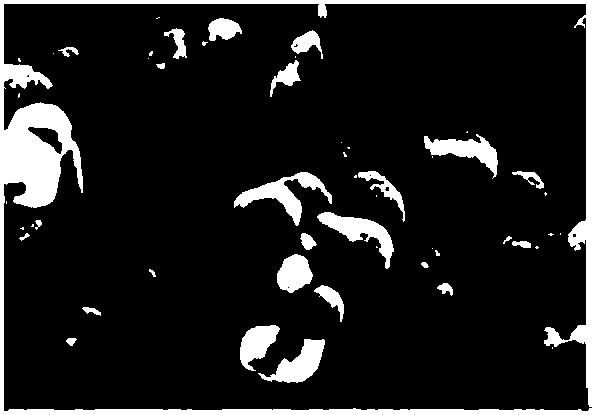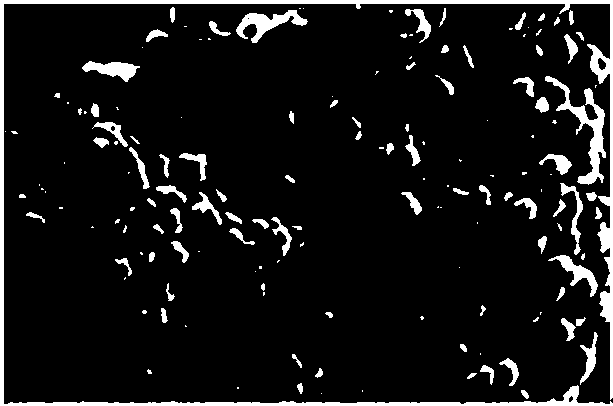Starch-based montmorillonoid composite adsorption material with various charges distributed on surface and preparation method of starch-based montmorillonoid composite adsorption material
A composite adsorption material, charge distribution technology, applied in chemical instruments and methods, adsorption water/sewage treatment, other chemical processes, etc., can solve problems such as rare reports in research, achieve fast sedimentation, strong adhesiveness, and improve flocculation performance. Effect
- Summary
- Abstract
- Description
- Claims
- Application Information
AI Technical Summary
Problems solved by technology
Method used
Image
Examples
Embodiment 1
[0047] The first step is to weigh 200g of corn dry starch into the reactor, add 800g of deionized water, stir evenly, and prepare a starch milk solution with a concentration of 20% by mass.
[0048] In the present embodiment, the scanning electron microscope picture of native starch magnified 2000 times is as figure 1 As shown, the surface of unmodified native starch is relatively smooth, and the particles are relatively dispersed.
[0049]The second step is to add 4g of NaOH solid to the starch milk solution, stir magnetically, mix evenly, place in the electrophoresis tank, adjust the voltage to 120v, and slowly add 20ml of 3-chloro-2-hydroxy with a mass concentration of 69% under the action of an electric field Propyltrimethylammonium chloride solution, placed in a water bath at 50°C for 4 hours, centrifuged the reacted solution, filtered to remove the supernatant, washed the precipitate three times alternately with absolute ethanol and deionized water, and then The precipi...
Embodiment 2
[0057] The first step is to weigh 200g of corn dry starch into the reactor, add 470g of deionized water, stir evenly, and prepare a starch milk solution with a concentration of 30% by mass.
[0058] The second step is to add 4g of NaOH solid to the starch milk solution, stir magnetically, mix evenly, place in the electrophoresis tank, adjust the voltage to 135v, and slowly add 120ml of 3-chloro-2-hydroxy with a mass concentration of 69% under the action of an electric field Propyltrimethylammonium chloride solution, reacted in a water bath at 40°C for 7 hours, centrifuged the reacted solution, filtered to remove the supernatant, washed the precipitate three times alternately with absolute ethanol and deionized water, and then washed the precipitate The material was dried, ground to powder, weighed and recorded the powder mass.
[0059] The third step weighs 6g sodium tripolyphosphate (Na 5 P 3 o 10 ·H 2 O) be dissolved in 50ml deionized water, add 12g urea (CO(NH 2 ) 2 )...
Embodiment 3
[0064] The first step is to weigh 200g of corn dry starch into the reactor, add 600g of deionized water, stir evenly, and prepare a starch milk solution with a concentration of 25% by mass.
[0065] The second step is to add 4g of NaOH solid to the starch milk solution, stir magnetically, mix evenly, place it in the electrophoresis tank, adjust the voltage to 150v, and slowly add 70ml of 3-chloro-2-hydroxypropyl with a mass concentration of 69% under the action of an electric field base trimethylammonium chloride solution, reacted in a water bath at 60°C for 5.5 hours, centrifuged the reacted solution, filtered to remove the supernatant, washed the precipitate three times alternately with absolute ethanol and deionized water, and then washed the precipitate Dry, grind to powder, weigh and record the powder mass.
[0066] The third step weighs 13g sodium tripolyphosphate (Na 5 P 3 o 10 ·H 2 O) be dissolved in 50ml deionized water, add 4g urea (CO(NH 2 ) 2 ), mix well, and...
PUM
 Login to View More
Login to View More Abstract
Description
Claims
Application Information
 Login to View More
Login to View More - R&D
- Intellectual Property
- Life Sciences
- Materials
- Tech Scout
- Unparalleled Data Quality
- Higher Quality Content
- 60% Fewer Hallucinations
Browse by: Latest US Patents, China's latest patents, Technical Efficacy Thesaurus, Application Domain, Technology Topic, Popular Technical Reports.
© 2025 PatSnap. All rights reserved.Legal|Privacy policy|Modern Slavery Act Transparency Statement|Sitemap|About US| Contact US: help@patsnap.com



